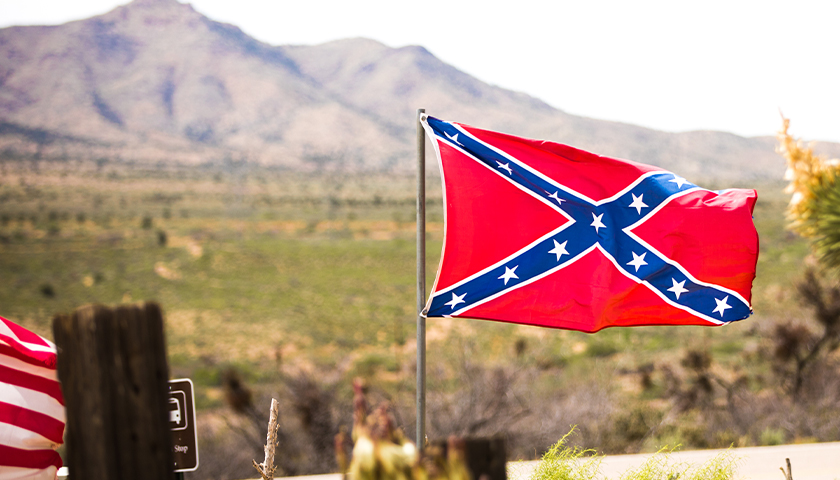by Pedro Gonzalez
Outside Christie’s home in upstate New York, nestled beneath a tree near her driveway, sits a small rock painted with a Confederate flag that could cost her the custody of her little girl.
In a row between parents identified only as Christie and Isaiah, the Appellate Division of the New York State Supreme Court’s Third Department unanimously allowed the pair to retain joint custody of their biracial child but ordered the mother to remove the rebel rock by June 1. Failing that, the court ruled the rock’s “continued presence shall constitute a change in circumstances.”
Put plainly, the bench threatened to revisit parents’ custody agreement and warned: “Family Court shall factor this into any future best interests analysis.”
It seems the parents have been locked in a protracted custody battle for some time. The New York Post reports that “the mother wants the dad to only see his daughter every other weekend, and the father wants sole custody.” In the course of the dispute, Isaiah has mentioned the rock only in passing while making a broader argument for custody of the girl. It was only when the case ended up in the lap of the appellate court that judges honed in on Christie’s taste in decor.
“Although not addressed by Family Court or the attorney for the child, the mother’s testimony at the hearing, as well as an exhibit admitted into evidence, reveal that she has a small confederate flag painted on a rock near her driveway,” Justice Stanley Pritzker wrote in the ruling. Pritzker then set his sights on the child’s racial background.
“Given that the child is of mixed race, it would seem apparent that the presence of the flag is not in the child’s best interests, as the mother must encourage and teach the child to embrace her mixed-race identity, rather than thrust her into a world that only makes sense through the tortured lens of cognitive dissonance,” Pritzker wrote. “Further, and viewed pragmatically, the presence of the confederate flag is a symbol inflaming the already strained relationship between the parties.”
How one feels about the Confederate flag is irrelevant to the real issue here. As Jason Leifer told Newsweek, the court “pulled something out of a hat” by making the rock the centerpiece of its decision. “The legal standard in a child custody case is ‘best interests of the child,’” said Leifer, who represented the child in the case. “A trial court weighs all of the evidence and legal arguments, then determines legal custody, placement, and visitation based upon what it feels is in the child’s best interests.”
“This part of the appellate decision was itself made upon an assumption that the mother (despite having a biracial child) held racist views, which was not supported by the evidence in the record,” Leifer added. “By making a ruling based upon this assumption, this Appellate Court simply opened the door for litigants in the Third Department to argue that a parents’ political views and opinions are harmful to a child without having to demonstrate actual harm.”
Leifer is right, but the court did much more than argue about the parents’ political views.
Pritzker and company interpreted the meaning of Confederate symbolism to Christie—in other words, symbols mean whatever the court says they mean. Further, the judges decided that it would be in the child’s best interests if her parents’ political views reflected their own. Further still, the court effectively mandated that as a condition of custody, the parents must steward the “child to embrace her mixed-race identity.”
Those who grin at the removal of Confederate symbolism from the public eye should know that the implications of this could and likely will extend far beyond Southern heritage.
Even though last year’s Black Lives Matter riots concluded as the most destructive in insurance history, Attorney General Merrick Garland on Wednesday told senators who the real threat in America is, according to federal authorities.
“Domestic violent extremists pose an elevated threat in 2021, and in the FBI’s view, the top domestic violent extremist threat we face comes from racially or ethnically motivated violent extremists, specifically those who advocate for the superiority of the white race,” Garland said.
The list of contraband symbolism, political views, and speech is sure to grow as the war on the specter of white supremacy escalates. Some might say that it is paranoid to suspect as much, an example of the slippery slope fallacy. Those people also thought that the toppling of statues would stop with Confederate monuments.
– – –
Pedro Gonzalez is a senior writer at American Greatness and a Mount Vernon Fellow of the Center for American Greatness. He publishes the weekly Contra newsletter. Follow him on Twitter @emeriticus.
Photo “Confederate flag” by Thomas Hawk CC 2.0.





